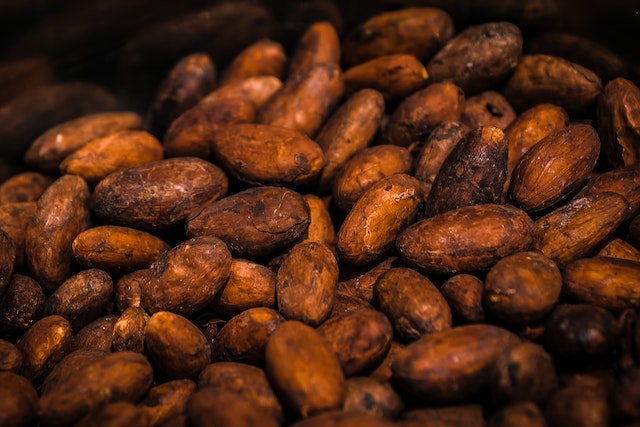
Dairy vs. Popular Plant Milks – Almond, Oat, Coconut, and Soy Milks
July 21, 2024
Cocoa Shortage and Rising Prices in 2024: What Consumers Should Know
July 21, 2024Palm Oil in Chocolate
What's the Big Deal?
It may surprise you to learn that the fuss over palm oil in chocolate is not about palm oil being bad for your health (we’ll talk about that, though).
The real issue with palm oil in chocolate is around the impact of palm oil production on the environment. We’re talking serious issues like large-scale deforestation, environmental pollution, damage to biodiversity, and loss of natural habitat for indigenous peoples and animals, especially the protected orangutan.
Some of these issues plague the cocoa industry, too. Just like in cocoa, the palm oil industry is trying to tackle these issues with sustainability schemes, which are not enough, just like in the chocolate sector.
We do not use palm oil to craft our chocolate bars or dairy-free chocolate spread. We practise regenerative agriculture and agroforestry on our cocoa farm in Cameroon, then create chocolate products with only cocoa butter as fat.
Palm Oil vs. Palm Kernel Oil

The fruit of the oil palm tree comprises the outer mesocarp or flesh where palm oil comes from and an inner kernel where palm kernel oil comes from.
Palm oil and palm kernel oil both come from the fruit of the oil palm tree. The main oil palm tree specie Elaeis guineensis is native to coastal West and Southwest Africa, but is now widely grown in Southeast Asia, Malaysia and Indonesia.
Palm oil, which is red or orange in its unprocessed form, comes from the flesh of the oil palm fruit. Meanwhile, palm kernel oil, yellowish or brown, comes from the seed of the same fruit.
Palm oil and palm kernel have similar uses, from cooking oil to diverse applications in the food, cosmetic, and beauty industries, and as biofuel.
As products of the same fruit, the concerns over their ecological impact are the same. This article uses the phrase palm oil, but the same issues concern palm kernel oil as both are used in the chocolate industry.
Why some chocolate companies use palm oil
Ferrero’s Nutella may be the most widely known chocolate containing palm oil, but there are other brands too. The Ethical Consumer assessed the palm oil policies of 84 chocolate brands from 25 companies, rating them according to their palm oil sourcing. While some brands fare well by not using palm ingredients, others do use certified sustainable palm ingredients, and some are not transparent about their palm ingredient sourcing. Ferrero, Nestle, Mondelez, and Mars got the worst rating for palm oil sourcing.
But the issue here isn’t about who’s better at using palm oil in their confections. Why do they use palm oil to begin with?
Chocolate makers use palm oil to replace cocoa butter partially or entirely. This is for various reasons.
· Palm oil is cheaper than cocoa butter: This means lower cost of production for chocolate manufacturers.
· Palm oil has a higher melting point than cocoa butter. Chocolate with palm oil stays solid at room temperature and maintains its smooth texture.
· Palm oil has a stable shelf life. This ensures the chocolate product maintains its freshness and quality for a longer time.
Not only in chocolate!
Palm oil is everywhere, from butter to coffee to toothpaste. The odds are you’ve used a product with a palm ingredient today, most likely unsustainable oil palm product.
This infographic from Green Match UK gives you a snapshot of your daily encounter with the world’s most popular vegetable oil.

Source: Green Match UK
The big question now is how can you tell there’s palm oil (or not) in the product you’re using or want to buy?
How palm oil production destroys the environment
The oil palm tree thrives in hot humid climates around the equator, an imaginary line that divides the earth horizontally into two. The equator runs across some countries and cities in Africa, South America, and Southeast Asia, with Indonesia, the world’s largest producer of palm oil, lying almost entirely in and around the equator.
These equatorial regions are home to the world’s rainforests. As home to millions of species of animals, insects, and medicinal plants, rainforests are essential to the wellbeing of our planet. They protect biodiversity, recycle carbon dioxide into oxygen, store water, and preserve soil health against erosion.
All these benefits of rainforests get threatened by large-scale production of palm oil with plantations covering 27 million hectares of the earth’s surface. To establish some of these plantations, companies slash and burn rainforests, displace indigenous peoples, and destroy biodiversity.
Other vegetable oils do not have these social and eco-harmful effects. For example, the production of peanut, soybean, coconut, or olive does not need forest areas to be cut down because these plants do well on grasslands.
Sustainable Palm Oil
Palm oil is getting such a bad rap everywhere that it’s hard to hear the voices of sustainable palm oil businesses. Interestingly, sustainable palm currently holds 20% of the global palm oil market, and this share may expand if stakeholders stick to sustainable practices.
The widely known certification on sustainable palm oil is the Roundtable on Sustainable Palm Oil, RSPO, a global scheme with over 4000 member organisations.
The requirements for palm oil producers to get certified by RSPO include:
· Production must not cause deforestation or damage protected forest areas.
· Producers must monitor and identify protected plant and animal species.
· No burning of land surface at any stage of production or use of fire to clear land to establish a plantation.
· There must be protection of workers’ rights and proper working conditions, including for vulnerable groups like migrants, refuges, women, and young workers.
· Workers must receive a decent living wage.
The challenges of sustainable palm oil on product labelling
Although certification criteria look sustainable on paper, one of the key challenges to sustainable palm oil is companies playing lip service.
Companies affiliated with the Roundtable on Sustainable Palm Oil still engage in shady practices that still encourage deforestation. A 2023 Gecko Project investigation uncovered an example of certified-sustainable companies using shadow companies to cut down rainforests in Indonesia to expand palm oil production.
The RSPO has also been reported to have lax membership and taking a long time to expel noncompliant members. This makes it hard to know if a certified-sustainable palm oil (CSPO) product is truly sustainable or whether the label is just a marketing face.
So yes, while there’s sustainable palm oil production, it poses enormous challenges that can be difficult for the consumer to track. Add this to the many synonyms for palm oil in various products, and it’s impossible for the average consumer to tell whether their money is promoting the negative environmental impact of unsustainable palm oil.
How to tell there’s palm oil in a chocolate (or other products)
Look at product labels. But be warned: it’s not that simple to identify palm oil in product labels. This is because palm oil is mostly sold in its refined forms, which are very different from the unprocessed reddish semi-solid oil extracted from the flesh of the palm fruit.
Africans may be the only ones who know that natural palm oil is red or orange, as many African dishes use palm oil in its natural form.

Eru is a Cameroonian vegetable soup that depends on a lot of natural palm oil. Image source: NI’s Kitchen
Most people in the West only know processed palm oil, golden in colour, and under a misleading generic name as vegetable oil. Misleading because vegetable oil may also mean soybean oil, sunflower oil, coconut oil, peanut oil, etc. European Union law requires transparent labelling, stating the use of palm oil, but other countries don’t.
To complicate matters for consumers, there are many synonyms for palm oil. So consumers have to memorise tons of synonyms to recognise palm oil in a product.
The stress-free way to avoid palm oil in chocolate is just to buy palm oil-free chocolate. Or be sure the palm oil in your chocolate and other products comes from a sustainable source.
Health benefits of palm oil
Because of the bad publicity palm oil has received for the negative impact of large-scale production on the environment, it is easier to assume palm oil is harmful to human health.
Unrefined palm oil, the crude form used in African cuisine, is rich in vitamin E and antioxidant carotenoids (where its red/orange colour comes from!) that the body converts into vitamin A.
Studies have linked palm oil to several health benefits including protecting brain function, reducing risk factors for heart disease, and vitamin A supplementation.
Unfortunately,
Refining palm oil reduces its nutritional benefits
The palm oil used in industrial production is refined by bleaching, deodorising, and neutralising crude palm oil to remove its reddish colour and earthy flavour. This comes at a cost of reducing some of its nutrients. About 50% of red palm oil’s antioxidants are lost to processing, and the extent of processing impacts the extent of nutritional and health benefit loss.
Crude or refined, palm oil is 50% saturated and unsaturated fat. Unsaturated fats are the good guys, while saturated fats are not so kind to human health, though results of research on their dangers are conflicting. However, a diet high in saturated fat, like the standard American diet, can increase your risk for heart disease and type 2 diabetes.
Cocoa butter has more saturated fatty acids than palm oil (60% vs. 50%), which confirms what we said at the beginning that the big deal about palm oil in chocolate is not that palm oil is unhealthy. Palm oil and cocoa butter both have benefits and downsides (like most food items). The big deal with palm oil in chocolate remains the social and environmental impact of palm oil production.
Should you only buy palm oil free chocolate?
No. If there’s proof that the palm oil in a chocolate was produced without harm to the environment or natural habitat, there’s no need to demonise the product. Although there are conflicting reports, companies are listening to the campaigns against cutting down rainforests for palm oil. The palm oil industry is trying to clean up its act, though some bad eggs are still paying lip service to sustainable certification.
The market share for sustainable palm oil is only 20% and that share goes to all the industries using palm oil in their products. Chances are that you don’t often come across chocolate with sustainable palm oil. Palm oil free chocolate is still the best way to avoid unsustainable palm oil in chocolate.
Practical steps to avoid unsustainable palm oil in chocolate and other products
· Look for palm oil in product label: This may be tricky if the manufacturer is not upfront with their labelling.
· If palm oil is used, make sure it’s sourced from a certified sustainable source. With sustainable palm oil available, there’s no reason to demonise palm oil in chocolate. Just be sure the palm oil is truly sustainably produced.
· Buy from brands you know and trust: the label ‘certified sustainable’ can be as much a marketing ploy as ‘palm oil free’. Businesses can cave in to consumer demands and put up a marketing face that’s not real. Know the chocolate brand you hand your money to.
· What else is in the product? ‘Palm oil free’ does not mean a product is healthy or healthier. The nutritional value of any product does not depend on what ingredient did not make the cut, but on what actually did go in. The product may still have unhealthy fats that are not palm oil.
We do not use palm oil in our chocolates
We employ ethical practices on our cocoa farm and throughout our supply chain from tree to bar. We don’t have to use ingredients we don’t have to use. Our chocolates are made with cocoa butter, not alternative fats.

Our delicious palm oil free chocolate spread
SEE ALSO: Alternatives to Nutella, Chocolate Spreads without Palm oil
Takeaway
The big deal about palm oil in chocolate is the negative impact of large-scale palm oil production on the environment: deforestation, displacement of indigenous communities, animal extinction, and human-driven climate change. As a consumer, you can use your wallet to advocate for sustainable practices. Say no to unsustainable palm oil in chocolates by buying palm oil free chocolate or only chocolates made with truly sustainable palm oil.
References
https://earth.org/the-challenges-of-sustainable-palm-oil-production-and-consumption/
https://www.researchgate.net/publication/323896716_The_nutritional_value_of_red_palm_oil
https://www.healthline.com/health/food-nutrition/saturated-and-unsaturated-fat
https://www.vox.com/science-and-health/2023/2/2/23568192/palm-oil-deforestation-sustainable
Chocolate Extinction: Fact vs. Fiction + What Chocolate Lovers Can Do
Chocolate ExtinctionFact vs. Fiction, What Consumers Can Do Share On Facebook Twitter Email Is the world really running out of chocolate? Not really. Currently the global […]
Corporate Chocolate Gifting Ideas to Appreciate Employees and Delight Clients
Corporate Chocolate GiftingHow to Appreciate Employees & Delight Clients Share On Facebook Twitter Email When it comes to corporate gifting, a one-gift-fits-all approach just doesn't cut […]
Cacao Supper Club at Home: Guide to Tasting Chocolate, Cacao Tea, and Pulp Juice
Cacao Supper Club at HomeGuide to Tasting Chocolate, Cacao Tea, and Pulp Juice Share On Facebook Twitter Email Imagine gathering around the table with a few […]





